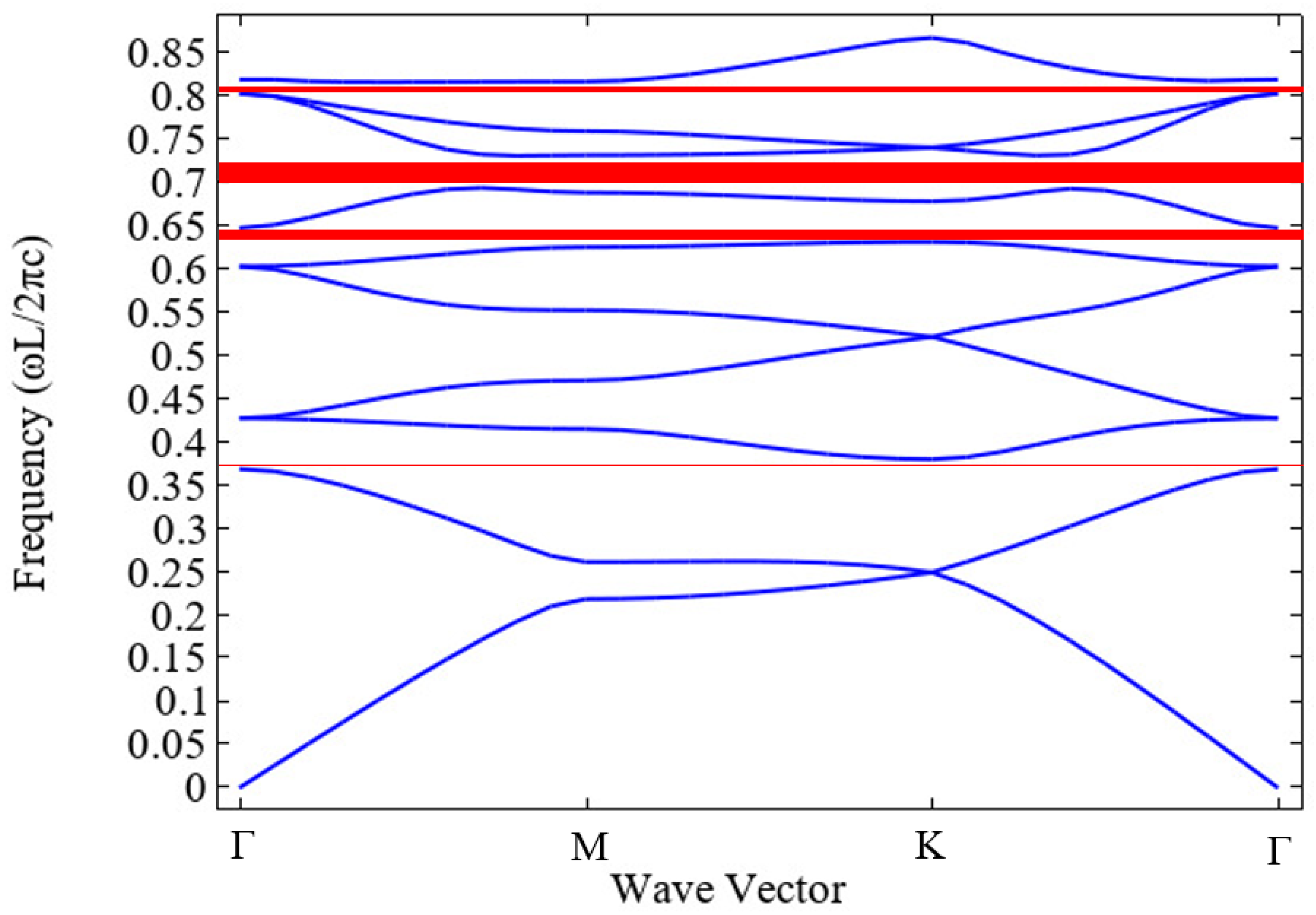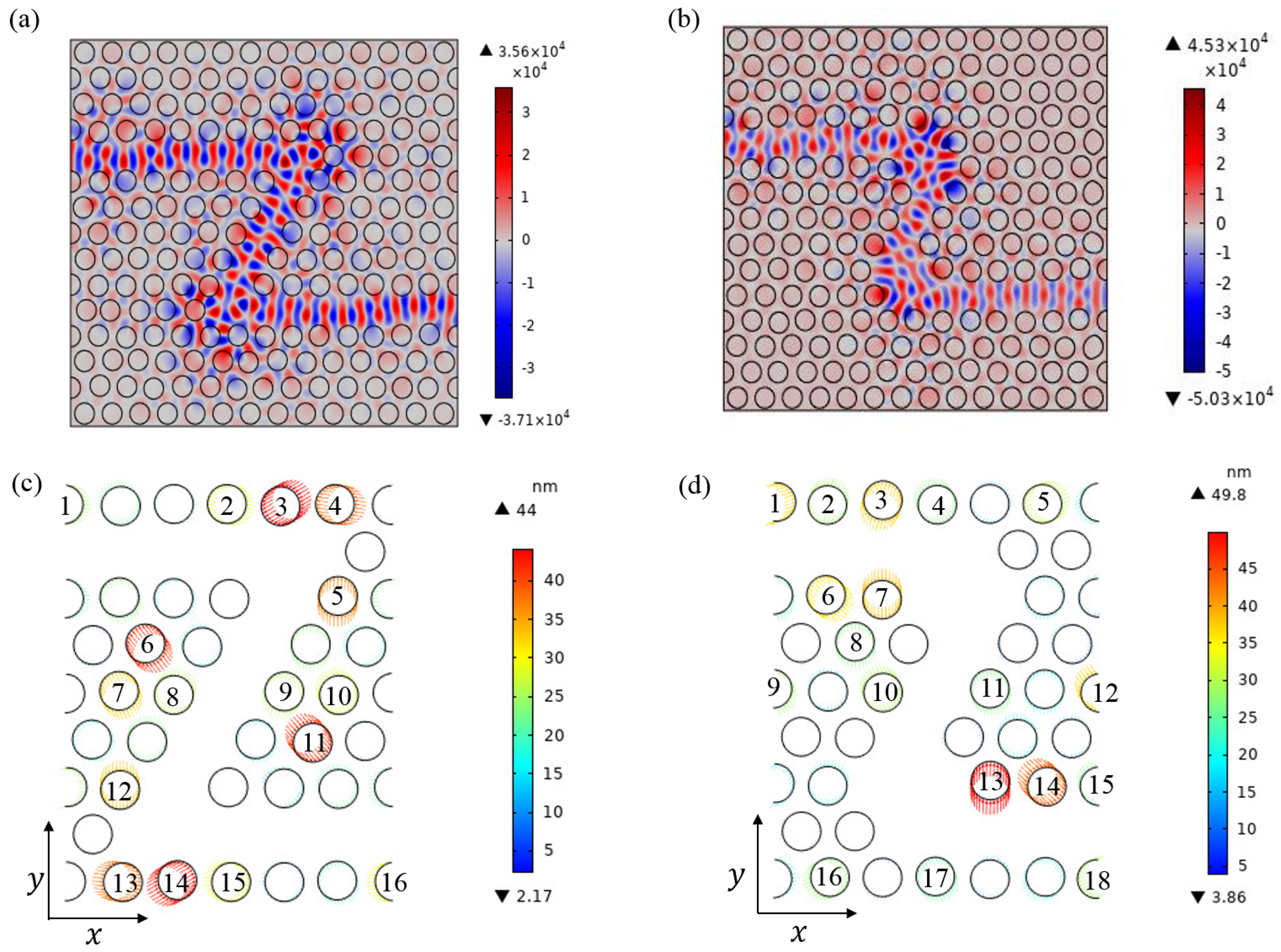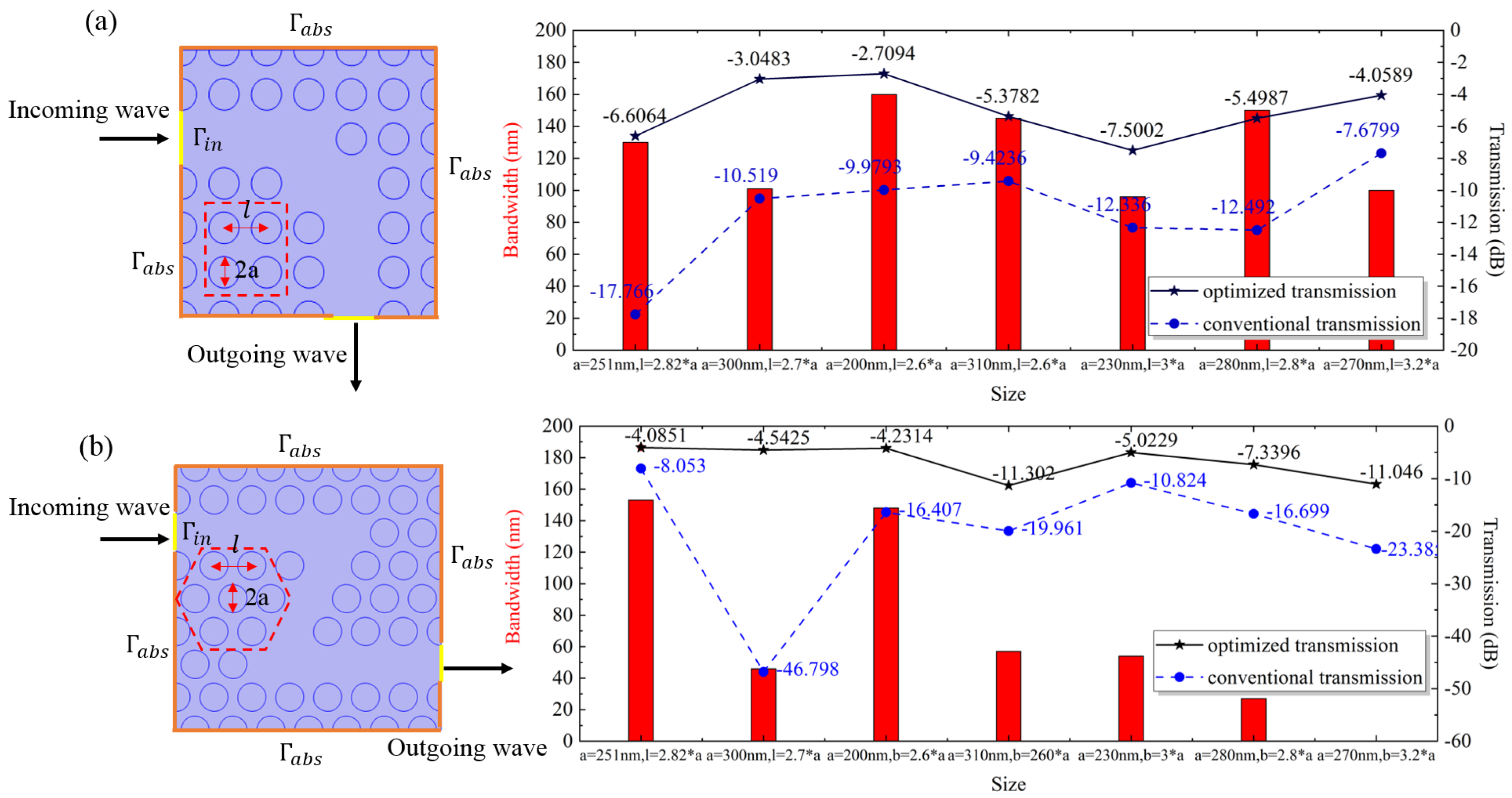Topology Optimization of Low-Loss Z-Bend 2D Photonic Crystal Waveguide
Abstract
1. Introduction
2. Model of Z Waveguide Bends
3. Results and Discussion
4. Conclusions
Author Contributions
Funding
Institutional Review Board Statement
Informed Consent Statement
Data Availability Statement
Acknowledgments
Conflicts of Interest
References
- Sakoda, K. Transmittance and Bragg reflectivity of two-dimensional photonic lattices. Phys. Rev. B 1995, 52, 8992. [Google Scholar] [CrossRef]
- Kefer, S.; Roth, G.L.; Zettl, J.; Schmauss, B.; Hellmann, R. Sapphire Photonic Crystal Waveguides with Integrated Bragg Grating Structure. Photonics 2022, 9, 234. [Google Scholar] [CrossRef]
- Yablonovitch, E. Inhibited spontaneous emission in solid-state physics and electronics. Phys. Rev. Lett. 1987, 58, 2059. [Google Scholar] [CrossRef] [PubMed]
- John, S. Strong localization of photons in certain disordered dielectric superlattices. Phys. Rev. Lett. 1987, 58, 2486. [Google Scholar] [CrossRef] [PubMed]
- Lourtioz, J.M.; Benisty, H.; Berger, V.; Gérard, J.; Maystre, D.; Tchelnokov, A.; Pagnoux, D. Photonic Crystals. Towards Nanoscale Photonic Devices; Springer: Berlin, Germany, 2006; pp. 121–122. [Google Scholar]
- Taya, S.A.; Ramahi, O.M.; Abutailkh, M.A.; Doghmosh, N.; Nassar, Z.M.; Upadhyay, A.; Colak, I. Investigation of bandgap properties in one-dimensional binary superconductor–dielectric photonic crystal: TE case. Indian J. Phys. 2022, 96, 2151–2160. [Google Scholar] [CrossRef]
- Ma, T.X.; Wang, Y.S.; Zhang, C. Investigation of dual photonic and phononic bandgaps in two-dimensional phoxonic crystals with veins. Opt. Commun. 2014, 312, 68–72. [Google Scholar] [CrossRef]
- Guo, H.; Hong, X.; Fan, H.; Fu, R.; Liu, X.; Li, Y.; Feng, S.; Chen, X.; Li, C.; Wang, Y. Polarization-independent waveguides based on the complete band gap of the two-dimensional photonic crystal slabs. Laser Phys. 2019, 29, 046205. [Google Scholar] [CrossRef]
- Butt, M.A.; Khonina, S.N.; Kazanskiy, N.L. 2D-Photonic crystal heterostructures for the realization of compact photonic devices. Photonics-Nanostruct.-Fundam. Appl. 2021, 44, 100903. [Google Scholar] [CrossRef]
- Zhao, Q.; Cui, K.; Huang, Z.; Feng, X.; Zhang, D.; Liu, F.; Zhang, W.; Huang, Y. Compact thermo-optic switch based on tapered W1 photonic crystal waveguide. IEEE Photonics J. 2013, 5, 2200606. [Google Scholar] [CrossRef]
- Khan, Y.; Noor, D.; Ullah, N.; Khonina, S.N.; Kazanskiy, N.L.; Butt, M.A. Design and Analysis of Femtosecond Laser-Generated Metasurface for Optical Filter Application. Photonics 2022, 9, 797. [Google Scholar] [CrossRef]
- Wang, P.Y.; Lai, Y.C.; Cheng, Y.C. Spatial Beam Filtering with Autocloned Photonic Crystals. Crystals 2019, 9, 585. [Google Scholar] [CrossRef]
- Jao, R.F.; Lin, M.C. Quantitative Analysis of Photon Density of States for One-Dimensional Photonic Crystals in a Rectangular Waveguide. Crystals 2019, 9, 576. [Google Scholar] [CrossRef]
- Wang, B.; Cappelli, M.A. A tunable microwave plasma photonic crystal filter. Appl. Phys. Lett. 2015, 107, 171107. [Google Scholar] [CrossRef]
- Djavid, M.; Monifi, F.; Ghaffari, A.; Abrishamian, M.S. Heterostructure wavelength division demultiplexers using photonic crystal ring resonators. Opt. Commun. 2008, 281, 4028–4032. [Google Scholar] [CrossRef]
- Wang, K.; Wang, H.; Wu, X.Y.; Zhang, Y.; Yang, D.; Jiao, R.; Wang, C. Ultrasound Sensing Using Packaged Microsphere Cavity in the Underwater Environment. Sensors 2022, 22, 4190. [Google Scholar] [CrossRef] [PubMed]
- Lu, B.; Fan, C.R.; Song, J.Y.; Wang, C. Optical Parametric Oscillation with Ultra-Low Power Threshold in a Dimer of Active-Passive Cavities. Crystals 2021, 11, 566. [Google Scholar] [CrossRef]
- Olthaus, J.; Schrinner, P.P.; Reiter, D.E.; Schuck, C. Optimal photonic crystal cavities for coupling nanoemitters to photonic integrated circuits. Adv. Quantum Technol. 2020, 3, 1900084. [Google Scholar] [CrossRef]
- Luna-Acosta, G.A.; Schanze, H.; Kuhl, U.; Stöckmann, H.J. Impurity effects on the band structure of one-dimensional photonic crystals: Experiment and theory. New J. Phys. 2008, 10, 043005. [Google Scholar] [CrossRef]
- Askari, M.; Momeni, B.; Soltani, M.; Adibi, A. Systematic design of wide-bandwidth photonic crystal waveguide bends with high transmission and low dispersion. J. Light. Technol. 2010, 28, 1707–1713. [Google Scholar] [CrossRef]
- Mekis, A.; Fan, S.; Joannopoulos, J.D. Bound states in photonic crystal waveguides and waveguide bends. Phys. Rev. B 1998, 58, 4809. [Google Scholar] [CrossRef]
- Sunil, N.; Jayakrishnan, V.; Somanathan, H.; Jha, A.K. Transmission Spectrum of a Typical Waveguide in Photonic Crystal with Tunable Width: Simulation and Analysis. In International Conference on Communications and Cyber Physical Engineering 2018; Springer: Singapore, 2018; pp. 203–209. [Google Scholar]
- Li, C.; Hu, X.; Gao, W.; Ao, Y.; Chu, S.; Yang, H.; Gong, Q. Thermo-optical tunable ultracompact chip-integrated 1D photonic topological insulator. Adv. Opt. Mater. 2018, 6, 1701071. [Google Scholar] [CrossRef]
- Zhao, Q.; Cui, K.; Feng, X.; Liu, F.; Zhang, W.; Huang, Y. Low loss sharp photonic crystal waveguide bends. Opt. Commun. 2015, 355, 209–212. [Google Scholar] [CrossRef]
- Yuan, J.; Yang, J.; Shi, D.; Ai, W.; Shuai, T. Design optimization of a low-loss and wide-band sharp 120° waveguide bend in 2D photonic crystals. Opt. Commun. 2016, 367, 356–363. [Google Scholar] [CrossRef]
- Borel, P.I.; Harpøth, A.; Frandsen, L.H.; Kristensen, M.; Shi, P.; Jensen, J.S.; Sigmund, O. Topology optimization and fabrication of photonic crystal structures. Opt. Express 2004, 12, 1996–2001. [Google Scholar] [CrossRef] [PubMed]
- Sayed, H.; Al-Dossari, M.; Ismail, M.A.; Abd El-Gawaad, N.S.; Aly, A.H. Theoretical Analysis of Optical Properties for Amorphous Silicon Solar Cells with Adding Anti-Reflective Coating Photonic Crystals. Photonics 2022, 9, 813. [Google Scholar] [CrossRef]
- Ren, G.; Zheng, W.; Zhang, Y.; Wang, K.; Du, X.; Xing, M.; Chen, L. Mode Analysis and Design of a Low-Loss Photonic Crystal 60° Waveguide Bend. J. Light. Technol. 2008, 26, 2215–2218. [Google Scholar] [CrossRef]
- Mekis, A.; Chen, J.C.; Kurl, I.; Fan, S.; Villeneuve, P.R.; Joannopoulos, J.D. High transmission through sharp bends in photonic crystal waveguides. Phys. Rev. Lett. 1996, 77, 3787. [Google Scholar] [CrossRef] [PubMed]
- Jensen, J.S.; Sigmund, O.; Frandsen, L.H.; Borel, P.I.; Harpoth, A.; Kristensen, M. Topology design and fabrication of an efficient double 90/spl deg/photonic crystal waveguide bend. IEEE Photonics Technol. Lett. 2005, 17, 1202–1204. [Google Scholar] [CrossRef]
- Jensen, J.S.; Sigmund, O. Topology optimization of photonic crystal structures: A high-bandwidth low-loss T-junction waveguide. JOSA B 2005, 22, 1191–1198. [Google Scholar] [CrossRef]
- Boscolo, S.; Conti, C.; Midrio, M.; Someda, C.G. Numerical analysis of propagation and impedance matching in 2-D photonic crystal waveguides with finite length. J. Light. Technol. 2002, 20, 304. [Google Scholar] [CrossRef]
- Konopsky, V. Design of 1D Photonic Crystals Sustaining Optical Surface Modes. Coatings 2022, 12, 1489. [Google Scholar] [CrossRef]
- Jin, J.M. The Finite Element Method in Electromagnetics; John Wiley & Sons: New York, NY, USA, 2015. [Google Scholar]
- Segovia-Chaves, F.; Vinck-Posada, H. Two-dimensional photonic crystals with insertion of circular and triangular defects. Optik 2021, 246, 167830. [Google Scholar] [CrossRef]
- Segovia-Chaves, F.; Vinck-Posada, H.; Navarro-Barón, E. Photonic band structure in a two-dimensional hexagonal lattice of equilateral triangles. Phys. Lett. A 2019, 383, 3207–3213. [Google Scholar] [CrossRef]





| Number | x (nm) | y (nm) | Number | x (nm) | y (nm) | Number | x (nm) | y (nm) | Number | x (nm) | y (nm) |
|---|---|---|---|---|---|---|---|---|---|---|---|
| 1 | −25.04 | 0.07 | 2 | −27.60 | 5.59 | 3 | −37.89 | −22.34 | 4 | −38.26 | 5.78 |
| 5 | 2.03 | 37.05 | 6 | −25.12 | 33.17 | 7 | −12.82 | 30.10 | 8 | −10.62 | −23.84 |
| 9 | 11.12 | 23.58 | 10 | 13.58 | −24.75 | 11 | 27.30 | −31.78 | 12 | 1.12 | −33.34 |
| 13 | 37.57 | −5.38 | 14 | 37.35 | 21.51 | 15 | 28.58 | −4.06 | 16 | 29.10 | 3.97 |
| Number | x (nm) | y (nm) | Number | x (nm) | y (nm) | Number | x (nm) | y (nm) | Number | x (nm) | y (nm) |
|---|---|---|---|---|---|---|---|---|---|---|---|
| 1 | 34.85 | 12.38 | 2 | −8.19 | −27.32 | 3 | 10.71 | 36.03 | 4 | 13.88 | −23.44 |
| 5 | −27.70 | −12.72 | 6 | −26.71 | 24.34 | 7 | −0.27 | −38.53 | 8 | −1.83 | −26.80 |
| 9 | −16.77 | 22.97 | 10 | 12.11 | −27.01 | 11 | −6.96 | 25.78 | 12 | 21.08 | −30.67 |
| 13 | 0.92 | 49.79 | 14 | 32.17 | −30.28 | 15 | 10.98 | −24.21 | 16 | 25.27 | 12.02 |
| 17 | −12.28 | 22.03 | 18 | −26.88 | −12.05 |
Disclaimer/Publisher’s Note: The statements, opinions and data contained in all publications are solely those of the individual author(s) and contributor(s) and not of MDPI and/or the editor(s). MDPI and/or the editor(s) disclaim responsibility for any injury to people or property resulting from any ideas, methods, instructions or products referred to in the content. |
© 2023 by the authors. Licensee MDPI, Basel, Switzerland. This article is an open access article distributed under the terms and conditions of the Creative Commons Attribution (CC BY) license (https://creativecommons.org/licenses/by/4.0/).
Share and Cite
Liu, G.; Wang, F.; Gao, Y.; Jia, B.; Guan, X.; Lu, P.; Song, H. Topology Optimization of Low-Loss Z-Bend 2D Photonic Crystal Waveguide. Photonics 2023, 10, 202. https://doi.org/10.3390/photonics10020202
Liu G, Wang F, Gao Y, Jia B, Guan X, Lu P, Song H. Topology Optimization of Low-Loss Z-Bend 2D Photonic Crystal Waveguide. Photonics. 2023; 10(2):202. https://doi.org/10.3390/photonics10020202
Chicago/Turabian StyleLiu, Gang, Fei Wang, Yongpan Gao, Baonan Jia, Xiaoning Guan, Pengfei Lu, and Haizhi Song. 2023. "Topology Optimization of Low-Loss Z-Bend 2D Photonic Crystal Waveguide" Photonics 10, no. 2: 202. https://doi.org/10.3390/photonics10020202
APA StyleLiu, G., Wang, F., Gao, Y., Jia, B., Guan, X., Lu, P., & Song, H. (2023). Topology Optimization of Low-Loss Z-Bend 2D Photonic Crystal Waveguide. Photonics, 10(2), 202. https://doi.org/10.3390/photonics10020202






